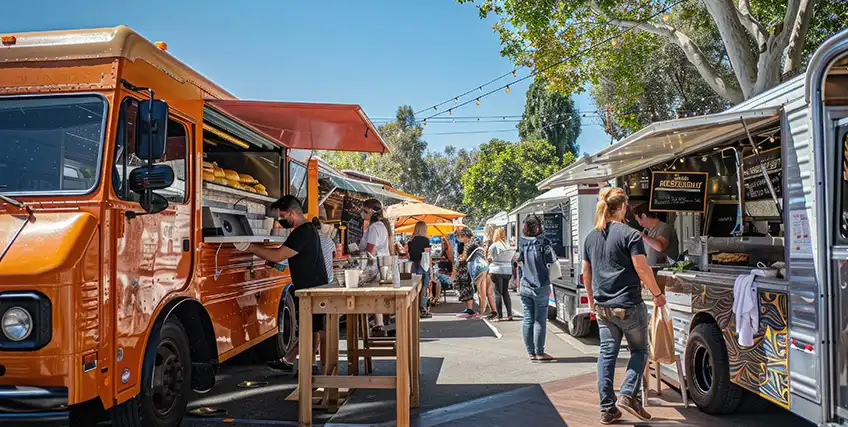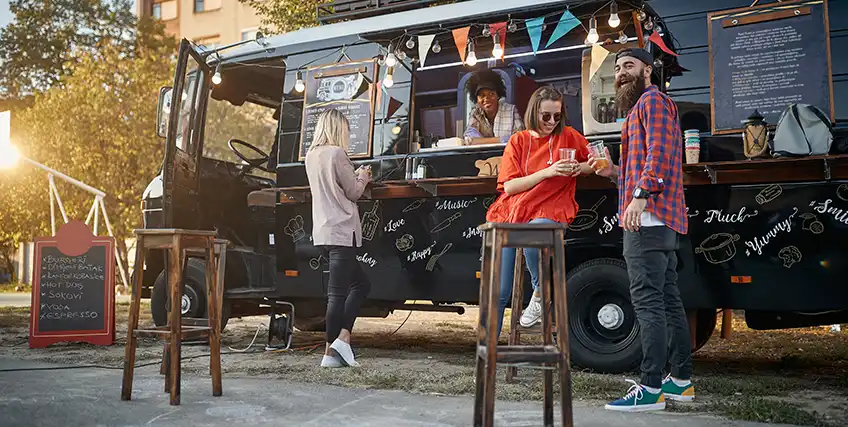Funding Your Food Truck Venture: Financing Tips to Grow Your Business
April 04, 2025 | Last Updated on: April 07, 2025

The food truck business has become one of the hottest eating trends in America. As a food truck operator, you undoubtedly want to experience sustainable growth that maximizes your ROI.
Serving up great cuisine and giving stellar customer service will go a long way toward ensuring successful operations but another key factor in growing your business is the ability to get a food truck business loan to keep it running smoothly—especially if you want to expand.
Let’s explore what you need to know about food truck business loans, strategies for growing your business and maximizing its revenue.
Tips For Success in Your Food Truck Business
In 2024, the food truck business had a market value of $1.8 billion in the United States, and the industry is projected to continue growing steadily over the next several years.
Overall, food trucks have a higher success rate in their initial years than full-service restaurant business models. They also have lower startup and overhead costs because of this, it may be easier to start and scale this type of business with a food truck small business loan than it would be to launch a traditional restaurant.
Here are our tips to help your food truck business thrive and be successful.
1. Research your local area
Gain a good understanding of your local market before jumping foot-first into the food truck business, especially if you are planning to take out a food truck business loan. First, find out how many food trucks operate in the area you intend to serve. Next, talk to local food truck operators.
- Check to see if you can identify trucks that have been around for a while, as it’s a sign that business is good.
- Learn what types of cuisine other food trucks offer and look for gaps in the market.
- Evaluate the food culture in your city and look for trends around food trucks. For example, you may find that there are plenty of taco trucks, but nobody serving upscale ice cream in a truck. There may be an opportunity to park your food truck business in a semi-permanent location, like at a brewery that doesn’t serve food.
2. Do something different
Explore your local food truck scene to see what everyone else is offering. If there are too many tacos stands or burger food carts, you’ll want to avoid offering the same thing. One of the keys to success will be differentiating your food truck business from its competition. Daring to be unique will increase your food truck’s value proposition. It will also be a consideration when you apply for a food truck business loan.
3. Come up with a food truck business plan
Running a food truck requires more than just a mobile kitchen and good grub. Like any other business, there are financial and operational considerations to ensure its growth and success. Even if your food truck business is already operational, you should have a business plan to meet its future needs.
A business plan helps you organize your food truck’s finances and outlines your goals. It’s also essential when you need a small business loan for food truck growth strategies to take your business to the next level.
A business plan includes:
- An executive summary. Include the following:
- What type of cuisine you will serve
- Identify your target customers
- Convey your mission, values, and vision for your food truck business
- A market analysis. This highlights the area you plan to operate your food business and identifies local competition and how you plan to distinguish yourself from them
- A financial plan. Lenders will look carefully at your financial statements when you apply for a food truck business loan.
- Your financial plan should include:
- Budget projections
- Financial statements such as cash flow sheets and profit & loss statements
- Business bank statements and tax returns
- Marketing strategies. Your marketing plan should illustrate how you intend to promote your business.
4. Brainstorm marketing strategies
Marketing is essential to establishing your food truck’s brand identity and helping it succeed. Get creative with marketing tactics to help you stand out from your competition.
- Leverage digital marketing strategies like SEO and social media marketing. Hire a marketing agency if you’re unsure how to accomplish this.
- Have a consistent presence on channels like Facebook and Instagram and engage your audience with giveaways, limited time offers, and immersive experiences.
- Leverage social media to inform customers where your truck will be parked and offer deals to the first 10 customers to generate additional excitement.
- Start a loyalty program to reward repeat customers. Have them sign up for email newsletters and engage them frequently to enhance customer engagement.
5. Think outside the box
Collaborate with other community members and partner with them for pop-up events like art walks or farmer’s markets to expand your reach and increase revenue. In addition to your food truck concept, consider catering services on the side to draw additional revenue for your food truck business.
6. Hire the right staff
At some point, you’ll probably need additional staff to help during busy hours. As you already know, the food truck business can be fast-paced in a cramped environment. Good workers are essential to ensure everything goes off without a hitch. Look for workers who are positive, thrive under pressure, and have excellent customer service skills as well as the skills needed to prepare food.
7. Set up in a high-traffic area
The great thing about operating a food truck is having the freedom to set up anywhere your permit allows. However, careful thought must be taken to ensure a steady stream of customers. Food trucks typically do well in business districts, during community events such as local music festivals, and busy parks.
8. Consider expanding once you’re successful
For many food truck owners, the dream doesn’t stop with just one food truck. Some operators have two or more trucks to serve in different areas of the city or multiple cities. Many operators also use their food truck business as a steppingstone to open the restaurant of their dreams. When you’re successful and bring in regular revenue and have operated for a couple of years or more, you might consider expanding and building out your operations maximizing your revenue. A food truck business loan can facilitate those needs and give you the capital needed to grow your business.
9. Choose your truck wisely
At first, you might consider using your food truck business loan to buy a used food truck rather than purchasing a new one. However, the risk of high maintenance costs and repairs is greater with a used truck. Having a working truck is essential to the success of your operations. You may also need to add plumbing, a generator, electrical wiring, gas connections, and a ventilation system if your food truck doesn’t already have those things. Plus, you’ll need to have the outside of your truck designed. In all, a new food truck can range from $50,000 to $175,000. A custom-designed truck will cost more but if you end up with a fleet of food trucks, it makes sense to have consistent branding across your fleet. The good thing is food truck business loans have higher approval rates. So, you can easily finance your food truck.
10. Finance your food truck venture
There are several types of food truck small business loans available. Food cart financing offers several benefits at various stages of your business operations.
Here are some food truck business loan options and financing options to consider:
- Equipment Financing: An equipment loan will fund your food truck equipment. This can include a used or new food truck, kitchen equipment, point of sale (POS) system, and more. It’s easier to qualify for since the equipment becomes security for this type of food truck business loan.
- Small Business Administration (SBA) Loans: SBA loans are popular for business owners and food truck operators because they typically have lower interest rates and can be used for a loan amount of up to $5,000,000. However, the loan application process can take months, except for microloans, which are usually approved faster. Meeting eligibility is also challenging, as the SBA is firm in its credit score requirements, which it sets at around 650. You’ll also need at least two years in business and strong financials to get an SBA food truck business loan.
- Term Loans: A term loan provides upfront cash in a lump sum and is repaid in equal monthly installments. The funds can be used for equipment, working capital, and business expansions. A good credit score of 650 or higher is usually needed to secure a food truck business loan.
- Business Credit Cards: Many food truck operators use business credit cards for some expenses like working capital. A credit card under your business’s name is a good way to build business credit while you try to qualify for a food truck business loan.
- Business Line of Credit: While not technically a food truck business loan, this financing option works similarly to credit cards. The lender approves a maximum credit limit. As you borrow from the limit, you’ll have less credit left. But as you repay it, the credit is added back.
- Revenue Based Financing: For borrowers with bad credit, a business loan for a food truck may be out of reach. However, alternative lenders have financing options available to meet this unique need. Alternative loan specialists consider more than credit alone and will work with you to get alternatives to a business loan for a food truck, like merchant cash advances and invoice factoring.
Final Thoughts
A food truck business can be highly scalable. When you’re ready to move on to the next stage of growth, a food truck business loan can give you the funding needed to see your vision come to life. Partnering with a loan specialist who understands the unique needs of the food truck industry is beneficial. They can advise you to ensure a smooth process when seeking funding options and implementing the right strategies to grow your business.
FAQs
How much does it cost to run a food truck?
A good food truck will likely cost on average around $100,000. All-in-all, it can cost up to $250,000 to get your food truck operation off the ground, not counting labor and food, making food truck business loans essential.
How much revenue can a food truck bring in?
A successful food truck can take in between $250,000 and $500,000 a year in larger cities. Food truck entrepreneurs in smaller cities usually bring in less.
Which menu items are profitable in the food truck business?
Burgers, loaded fries, global fusion cuisine, tacos, grilled cheese, fried chicken, vegan bowls, and specialty beverages like Boba Tea or Cold Brew often bring in good profit in the food truck industry.
What credit score is needed for favorable business financing terms for food truck business loans?
For the best financing terms on your food truck small business loan, you’ll need a score of 700 or more. You can still get funded with slightly higher rates and shorter repayment terms with a score of 650 or higher. Anything under that will likely have higher interest rates for your food truck business loan.
How much down payment do I need for food truck financing?
Many factors impact how much down payment is required on food truck business loans. The figure often ranges between 10-25%. If you have a strong business record and the loan is secured, you may be able to qualify for a smaller downpayment.




